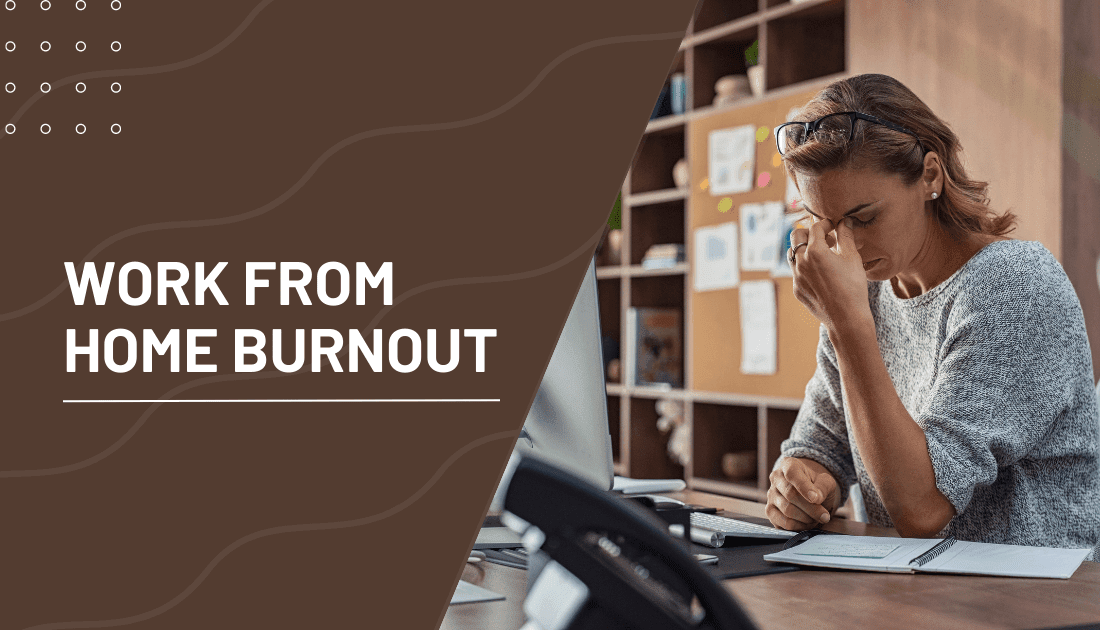In today’s ever-evolving work landscape, the concept of working from home has become increasingly prevalent. While it offers flexibility and convenience, it also brings its own set of challenges, including the risk of work-from-home burnout.
This article will delve into the symptoms, causes, and prevention strategies for work from home burnout.
By understanding the signs and implementing effective measures, individuals and organizations can foster a healthy work environment that promotes well-being and productivity. Let’s explore how to recognize, prevent, and overcome work-from-home burnout.
Take charge of your recurring tasks and organize your workflow effortlessly with Onethred’s intuitive Kanban board. Start your FREE trial today and experience a seamless project management solution!
What is Work From Home Burnout?
When we hear the term “burnout,” we often think of it in relation to a high-stress office environment. But work-from-home burnout is a whole different beast. It’s that feeling of being constantly overwhelmed, mentally drained, and physically exhausted, all while working from our homes.
One major factor contributing to work-from-home burnout is the blurring of boundaries between our personal and professional lives. Without a clear separation between work and leisure time, it can be challenging to switch off and recharge.
We may find ourselves checking emails late into the night or working on weekends, which ultimately leads to an unhealthy imbalance.
Another aspect contributing to this burnout is the lack of social interaction with remote work. Human connection plays a vital role in well-being and productivity, so when we’re isolated for long periods without regular face-to-face interactions with colleagues, friends, or family members, it can take a toll on our mental health.
There’s also an added pressure to prove ourselves when working remotely constantly. The fear of being seen as less productive or dedicated than our office-bound counterparts can lead us to overwork and push ourselves beyond healthy limits.
Understanding Work-from-Home Burnout
What Does Work Burnout Feel Like?
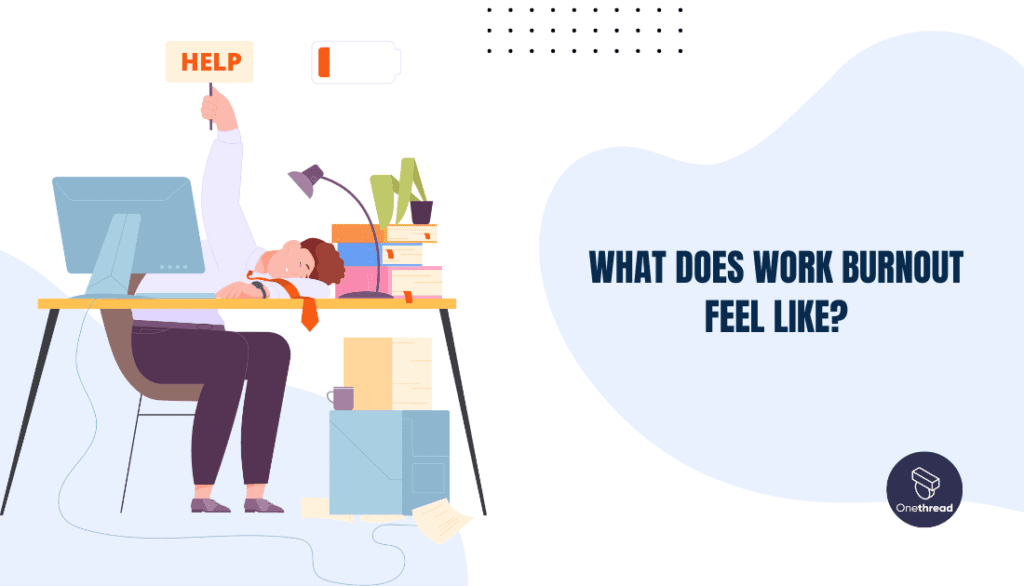
Burnout extends beyond mere tiredness or stress; it represents a state of persistent physical and emotional depletion arising from prolonged work-related stress. Individuals experiencing work burnout may feel depleted, demotivated, and detached from their work.
Work from Home Burnout Symptoms
- Emotional and Mental Exhaustion
Work-from-home burnout often manifests as emotional and mental exhaustion. Individuals may feel drained, overwhelmed, and emotionally detached from their work and colleagues. - Decreased Job Satisfaction and Engagement
Burnout can lead to decreased job satisfaction, causing individuals to feel disengaged, unfulfilled, and detached from their work responsibilities. - Increased Frustration and Irritability
Burnout can contribute to heightened frustration and irritability. Individuals may become easily agitated, experience mood swings, and have difficulty managing their emotions. - Physical Fatigue and Insomnia
Work-from-home burnout can manifest physically, resulting in chronic fatigue, lack of energy, and difficulties with sleep patterns, including insomnia. - Lack of Motivation and Productivity
Burnout often leads to a decrease in motivation and productivity. Individuals may struggle to focus, lack creativity, and experience a decline in their overall performance.
Identifying Red Flags: Signs of Work-from-Home Burnout
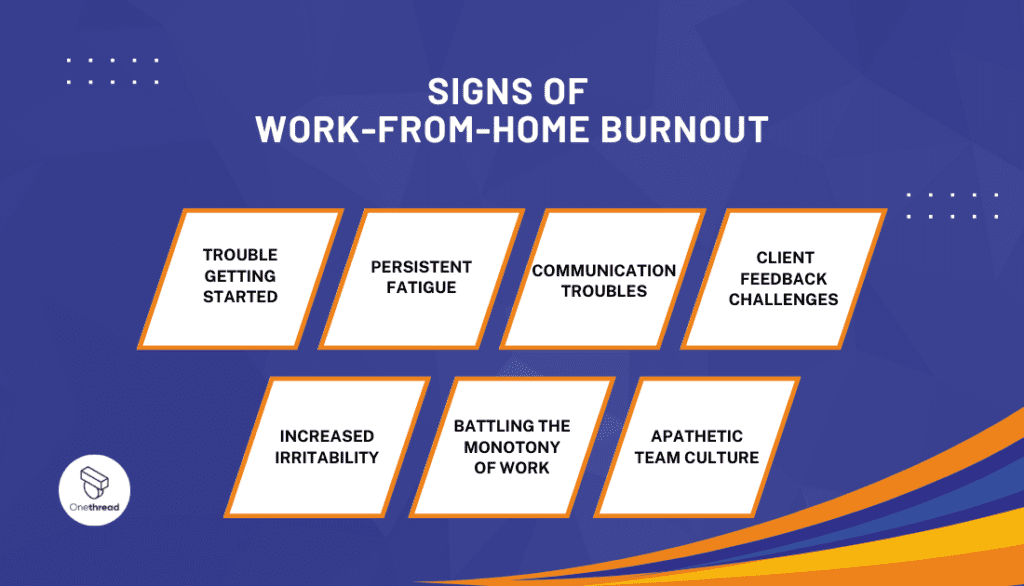



Work-from-home burnout is a state of physical, mental, and emotional exhaustion resulting from prolonged remote work. Identifying red flags early on can help prevent burnout and promote a healthier work-life balance. Here are some signs of work-from-home burnout:
Trouble Getting Started
One of the red flags of work-from-home burnout is difficulty initiating work tasks. Individuals may procrastinate, experience a lack of motivation, and struggle with concentration.
Persistent Fatigue
One of the most prominent signs of work-from-home burnout is persistent fatigue, characterized by a consistent feeling of tiredness and low energy levels, even after adequate rest.
Remote work’s stress, workload, and emotional strain can take a toll on physical and mental well-being, leaving individuals drained and making daily tasks challenging to accomplish effectively.
Communication Troubles
Burnout can lead to communication challenges, resulting in difficulty expressing thoughts, ideas, or concerns effectively. Individuals may withdraw from social interactions and experience feelings of isolation.
Client Feedback Challenges
Work-from-home burnout can impact the quality of client interactions. Individuals may receive negative feedback due to decreased attentiveness, lack of focus, or reduced responsiveness.
Increased Irritability
When employees experience burnout, the chronic stress and exhaustion can take a toll on their emotional well-being. As a result, they may find themselves becoming more irritable, easily frustrated, or experiencing frequent mood swings.
Battling the Monotony of Work
Burnout often arises from the monotony of work tasks. Individuals may find their work repetitive, unchallenging, and devoid of excitement, leading to decreased engagement and satisfaction.
Apathetic Team Culture
Work-from-home burnout can affect team dynamics, leading to an apathetic culture. Individuals may experience a lack of support, collaboration, and camaraderie, further contributing to burnout.
The Role of Employee Engagement in Preventing Work from Home Burnout
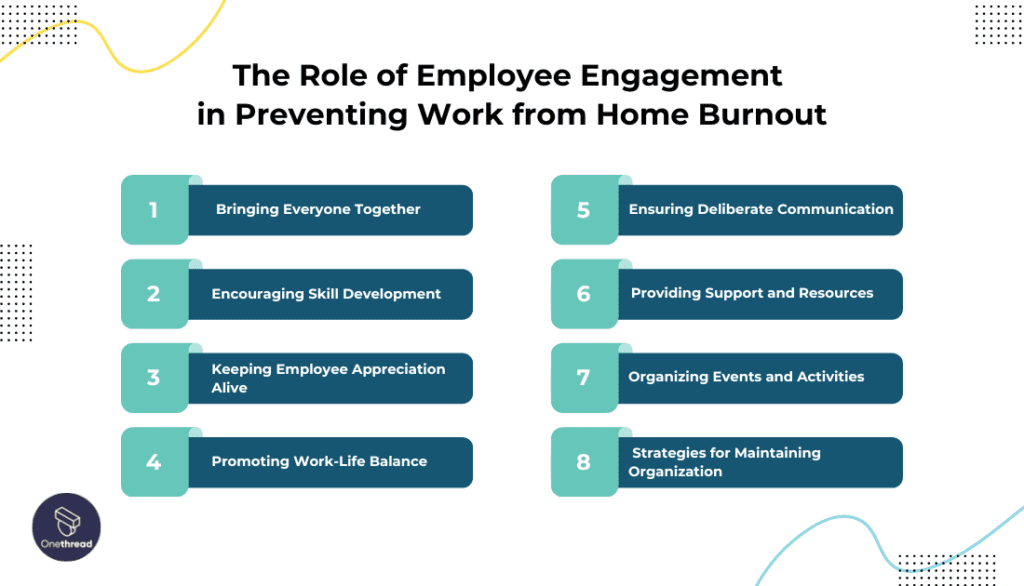



Employee engagement plays a crucial role in preventing work-from-home burnout. When employees are engaged in their work and connected to their organization, they are more likely to experience higher job satisfaction, lower stress levels, and better overall well-being. Here’s how employee engagement can help prevent work-from-home burnout:
1. Bringing Everyone Together
Fostering a sense of unity and togetherness is crucial in combating work-from-home burnout. Employers can organize virtual team-building activities, encourage open communication, and provide opportunities for social interaction.
2. Encouraging Skill Development
Engaged employees are more likely to participate in skill development opportunities and career growth initiatives. Continuous learning and personal development can combat burnout by providing individuals with a sense of progress and achievement.
3. Keeping Employee Appreciation Alive
Recognizing and appreciating employees’ efforts is vital for preventing burnout. Employers can express gratitude, acknowledge achievements, and provide incentives to motivate and engage employees.
4. Promoting Work-Life Balance
Engaged employees are better equipped to establish healthy boundaries between work and personal life, leading to improved work-life balance. This balance helps prevent burnout by allowing individuals to recharge and prioritize self-care outside of work hours.
5. Ensuring Deliberate Communication
Clear and deliberate communication is key to preventing work-from-home burnout. Employers should establish efficient communication channels, encourage regular check-ins, and ensure employees have access to the necessary tools and resources.
6. Providing Support and Resources
Engaged organizations prioritize employee well-being by offering resources and support to address burnout proactively. This may include mental health services, wellness programs, and flexible work arrangements to help employees manage stress.
7. Organizing Events and Activities
Virtual events and activities can foster team bonding and alleviate burnout. Employers can arrange online workshops, wellness sessions, and virtual social gatherings to promote employee well-being.
8. Strategies for Maintaining Organization
Implementing effective organizational systems and tools can help reduce work-from-home burnout. Employers can provide project management software, establish clear expectations, and offer resources for organizing work tasks efficiently.
8 Effective Tips to Prevent Work-from-Home Burnout
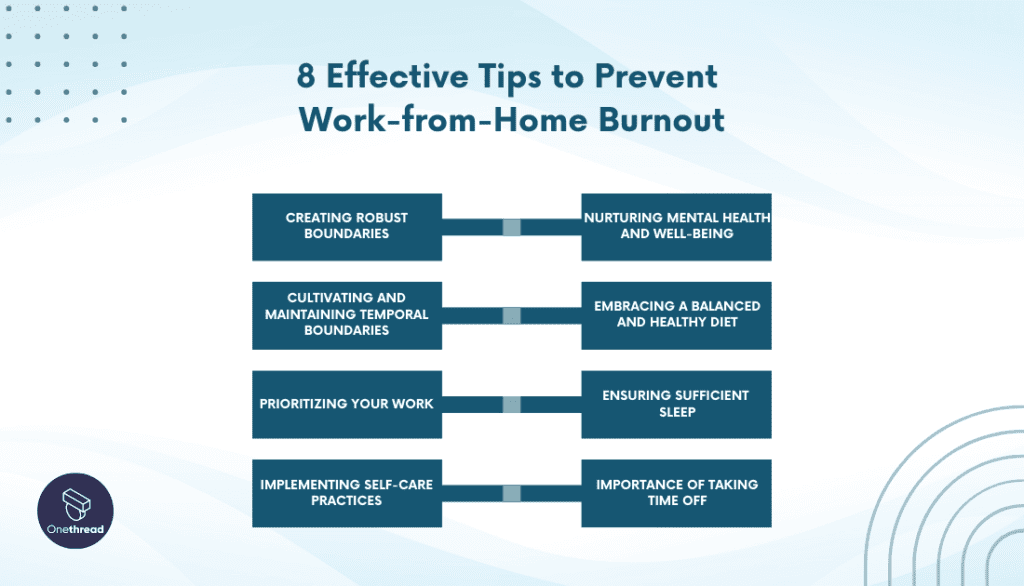



Now let’s see how we can stop Work-from-home burnout before it creeps in our lives:
1. Creating Robust Boundaries
Establishing clear boundaries between work and personal life is essential to prevent burnout. Individuals should define dedicated workspaces, set specific work hours, and separate work-related activities from personal time.
2. Cultivating and Maintaining Temporal Boundaries
Maintaining temporal boundaries is crucial for achieving work-life balance. Individuals should schedule regular breaks, plan leisure activities, and adhere to set work hours to avoid work encroaching on personal time.
3. Prioritizing Your Work
Effectively managing workload and setting priorities can reduce the risk of burnout. Individuals should identify key tasks, break them into manageable chunks, and focus on high-priority assignments to enhance productivity.
4. Implementing Self-Care Practices
- Taking Breaks and Resting
Regular breaks throughout the workday help combat burnout. Individuals should take short breaks to relax, stretch, and recharge their minds. - Incorporating Regular Exercise
Engaging in physical activity is crucial for maintaining well-being. Regular exercise improves mood, boosts energy levels, and reduces stress, contributing to a healthier work-life balance. - Carving Out “Me Time”
Allocating time for personal hobbies, interests, and relaxation is vital. Individuals should engage in activities they enjoy, such as reading, listening to music, or pursuing creative endeavors. - Establishing a Daily Routine
Creating a structured daily routine can enhance productivity and reduce burnout. Individuals should establish consistent wake-up and bedtime routines, plan meals, and incorporate time for self-care and leisure activities.
5. Nurturing Mental Health and Well-being
Prioritizing mental health is essential in preventing work-from-home burnout. Individuals should practice stress reduction techniques, engage in mindfulness exercises, and seek support through therapy or counseling if needed.
6. Embracing a Balanced and Healthy Diet
Maintaining a nutritious diet plays a significant role in overall well-being. Individuals should consume a balanced diet rich in fruits, vegetables, whole grains, and lean proteins to support physical and mental health.
7. Ensuring Sufficient Sleep
Getting adequate sleep is crucial for recharging the mind and body. Individuals should establish a consistent sleep schedule, create a comfortable sleep environment, and practice relaxation techniques to improve sleep quality.
8. Taking Regular Breaks
Taking regular breaks and vacations is essential for recharging and preventing burnout. Individuals should utilize their allotted time off to relax, rejuvenate, and disconnect from work responsibilities.
The Impact of Hybrid Work Models on Work-from-Home Burnout
Pros and Cons of Working from Home
Pros of Working from Home:
- Flexibility in work schedule
- Reduced commuting time and expenses
- More comfortable and personalized work environment
- Increased autonomy and independence
- Potential for better work-life balance
- Fewer workplace distractions
- Enhanced focus and productivity for some individuals
- Reduced exposure to office politics
Cons of Working from Home:
- Social isolation and decreased team collaboration
- Blurred boundaries between work and personal life
- Potential feelings of loneliness or disconnection
- Dependency on self-motivation and discipline
- Limited access to office resources and equipment
- Distractions from household responsibilities
For those who work from home, maintaining a healthy lifestyle is crucial to preventing stress and burnout. One key aspect of this is proper nutrition, which can significantly impact energy levels and mental well-being.
Employing personalized nutrition plans offered by registered dietitians can provide tailored dietary advice that suits individual needs, preferences, and health conditions. These plans not only help in maintaining an optimal diet but also support individuals struggling with balancing professional demands and personal health.
Balancing Remote and In-Office Work
Striking the right balance between remote and in-office work is crucial in preventing burnout. Employers should design hybrid work models that promote collaboration, provide social interactions, and establish clear expectations.
Strategies for Enhancing Work-Life Balance
Hybrid work models require strategies to enhance work-life balance. Individuals should leverage the flexibility of remote work, establish routines, and utilize technology to stay connected with colleagues.
Overcoming Work from Home Burnout: Coping Strategies and Support
1. Seeking Professional Help if Needed
When work-from-home burnout becomes overwhelming, seeking professional help is crucial. Individuals should not hesitate to consult therapists or counselors to address underlying mental health concerns.
2. Building a Support Network
Cultivating a support network is vital in overcoming burnout. Individuals should connect with colleagues, friends, or family members to share experiences, seek advice, and receive emotional support.
3. Practicing Mindfulness and Stress Reduction Techniques
Mindfulness exercises, such as meditation or deep breathing, can help manage stress and promote well-being. Individuals should incorporate these techniques into their daily routines to combat work-from-home burnout.
4. Utilizing Technology to Enhance Collaboration and Communication
Leveraging technology tools can enhance collaboration and combat feelings of isolation. Individuals should utilize video conferencing, instant messaging platforms, and project management software to stay connected and engaged.
Some Key Work-From-Home Burnout Statistics
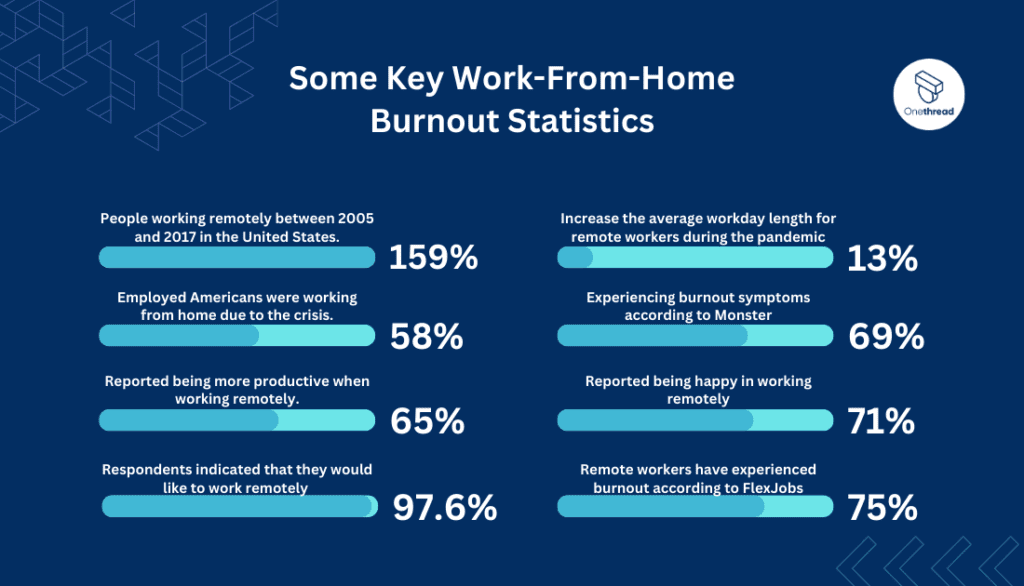



Here are some key statistics on this issue.
- Before the COVID-19 pandemic, remote work was already on the rise. According to Global Workplace Analytics, the number of people working remotely increased by 159% between 2005 and 2017 in the United States.
- The COVID-19 pandemic has accelerated the adoption of remote work. A survey by Gallup found that during the pandemic, 58% of employed Americans were working from home due to the crisis.
- In a survey conducted by FlexJobs, 65% of respondents reported being more productive when working remotely.
- According to Buffer’s State of Remote Work 2021 report, 97.6% of respondents indicated that they would like to work remotely for the rest of their careers at least some of the time.
- The National Bureau of Economic Research reported a 13% increase in the average workday length for remote workers during the pandemic, potentially contributing to burnout.
- In a survey conducted by Monster, 69% of remote workers admitted to experiencing burnout symptoms, with increased workload and blurred work-life boundaries being the primary causes.
- Research by Owl Labs reveals that remote workers experience higher job satisfaction compared to on-site workers. 71% of remote workers reported being happy in their jobs, compared to 55% of on-site workers.
- The Global Workforce Analytics survey estimated that employers could save over $11,000 per half-time remote worker annually in the United States through increased productivity, reduced office space, and lower absenteeism rates.
- A study conducted by Stanford University found that remote workers experience lower stress levels than their office-based counterparts, resulting in higher job satisfaction and reduced turnover rates.
- According to a survey by FlexJobs, 75% of remote workers have experienced burnout at least some of the time while working from home.
Remember to verify and update these statistics with recent and credible sources for the most accurate information on the current state of remote work.
Conclusion
In conclusion, work from home burnout is a real concern in the modern work environment. By recognizing the symptoms and implementing preventive strategies, individuals and organizations can mitigate the risk of burnout and foster a healthy work-life balance.
Incorporating robust boundaries, self-care practices, and maintaining open communication are essential steps toward preventing and overcoming work-from-home burnout.
Embracing hybrid work models and seeking support when needed can further contribute to overall well-being. By prioritizing self-care and addressing work-from-home burnout, individuals can thrive in their remote work setups and enjoy the benefits of a balanced and fulfilling professional life.
Remember, a healthy work-life balance is the key to long-term success and happiness in the ever-evolving work landscape.
FAQ Section
Q: How can I prevent Work-from-Home Burnout?
A: To prevent burnout while working remotely, it’s important to establish clear boundaries between work and personal life. Set specific work hours and stick to them. Take regular breaks throughout the day to recharge. Engage in activities that help you relax and destress outside of work hours.
Q: How can I overcome Work-from-Home Burnout?
A: Overcoming burnout requires self-care strategies such as practicing mindfulness techniques like meditation or deep breathing exercises.
Stay connected with colleagues virtually to combat feelings of isolation. Seek support from friends or family members if needed. Consider talking to a therapist who specializes in stress management.
Q: Can working from home cause burnout?
A: Yes, working from home can indeed cause burnout. Blurring boundaries between work and personal life, increased workload, isolation, and the lack of separation between work and rest can contribute to work-from-home burnout.
Establishing clear boundaries, implementing self-care practices, and maintaining a healthy work-life balance are essential to prevent burnout when working from home.
Q: How long does work burnout last?
The duration of work burnout can vary from person to person. It depends on several factors, including the severity of burnout, the individual’s ability to implement self-care strategies, and the support available.
With proper self-care and support, burnout symptoms can improve over time. However, if left unaddressed, burnout can persist for an extended period. Taking proactive steps to prevent and address burnout is essential to ensure timely recovery.
